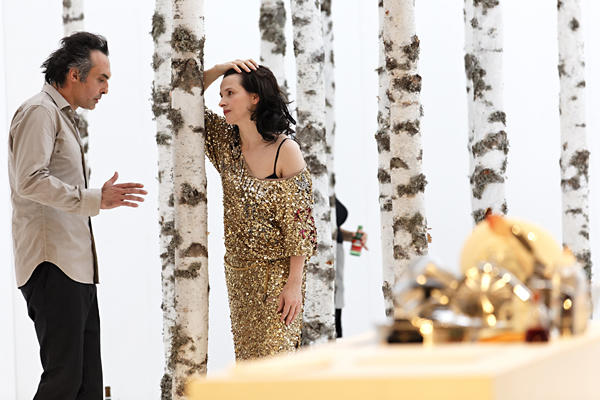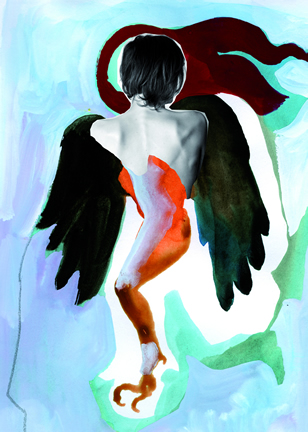… a situation which puts the lid on the coffin of a generation.
Strindberg
To join together on stage two artists like Juliette Binoche and Nicolas Bouchaud (whom we saw perform at the Odéon in all the productions of Jean-François Sivadier), one of the most intense, poignant confrontations in theatrical repertory was indispensable. The author of The Dance of Death has us witness a horrible duel between an ambitious, seductive, highly gifted valet and a young woman who is far too conscious of the superiority of her own position, who feels herself captive at the top of a high pillar and who, to pass the time, invents rather cruel games where she has perfected the mastery of men. Everything seems to take place both in the space of a few hours during a midsummer night – from the final Midsummer’s Night dances until the dawn of the following day – and simultaneously within a time which escapes any objective measurement, a sort of oneiric flow from the bottom of which surface memories, seemingly unlinked images which gradually weave their nets as if to catch the heroine in their trap. Outdoors the festival continues, without His Lordship, the Count. Indoors it is at first wine which flows, glass after glass, while the tension mounts between the young mistress of the house and the young man troubled by her, and while their suggestive but hedging conversation, moving from one level to another, hesitates between the formal and the familiar, between the “vous” and the “tu”….But what, exactly, do “outdoors” and “indoors” mean? Isn’t what draws these two to each other, yet at the same time hinders this closeness to be found above all in themselves? Fisbach has not forgotten that Strindberg himself said that his play was a “battle between brains,” un hjärnonas kamp, as Régis Boyer writes, “that isn’t necessarily expressed through crimes in the common use of the term, but by a slow psychic assassination where, starting with psychological means (suggestions, perfidious insinuations, the introduction of a lethal doubt in the consciousness of the target, hypnosis, hallucinations carefully encouraged, etc.) the aim is to lead to ruination the exceptional person whose presence among us is intolerable.”…A space for this “psychic murder” (själamord) had to be invented, a space that makes palpable the fact that the struggle between these two beings, the prison in which they wage their battle, lies first and foremost within themselves. Fisbach has decided on a radical solution which has as its principle the liberation from the naturalistic conceptions of the décor that Strindberg had insisted on, so as to modernize events (or, rather, to “intemporalize” them, render them timeless), while concentrating our attention on the bodies before us. More than ever, then, everything is at stake in the deadly ballet between Jean and Julie. The fact that one is played by Nicolas Bouchaud and the other by Juliette Binoche is more than promising for an unforgettable production.
Cast
by August Strindberg
directed by Frédéric Fisbach
May 18th – June 24th, 2012
Théâtre de l'Odéon / 6e
French translation : Terje Sinding
Artistical collaboration : Raphaëlle Delaunay
Dramaturgy : Benoît Résillot
Scenography & lights : Laurent P. Berger
Costumes : Alber Elbaz pour Lanvin
With Juliette Binoche, Nicolas Bouchaud, Bénédicte Cerutti & a chorus
production déléguée Festival d’Avignon
coproduction Odéon-Théâtre de l’Europe, les Théâtres de la ville de Luxembourg, Théâtre Liberté, Barbican – Londres, La Comédie de Reims Centre dramatique national, CDDB Théâtre de Lorient Centre dramatique national, France Télévisions, Compagnie Frédéric Fisbach avec le soutien de la Région Île-de-France et de la maison Lanvin
avec le soutien spécial de SPAC-Shizuoka Performing Arts Center
le Festival d'Avignon reçoit le soutien de l'Adami pour la production
Created on July 8th, 2011, at the Gymnase Aubanel, Festival d'Avignon, 65th edition
,



